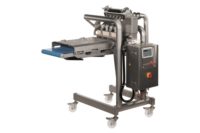The forming equipment industry has responded to consumers’ demands, and, therefore, the processors’ needs to provide a variety of different patty and nugget forms.
“With the demand for different thickness, diameters and weights, plants need to consider customer needs carefully,” says Robert Delmore, a professor in the Department of Animal Sciences at Colorado State University in Fort Collins.
Raw material quality still is the top factor affecting the ability of meat and poultry to be formed into quality products. Generally, chicken trimmings and tougher cuts of beef are used in the batter for formed nuggets or patties.
Some considerations regarding beef trimming are important to ensure a high-quality patty, Delmore says. For example, a few things to consider is the blend of fat and lean trimmings from different sources. Lean cow trimmings on their own typically do not make a highly palatable beef patty, he explains. Processors, therefore, add fed-beef trimmings as a fat source to the cow/bull trimming, the lean source, to achieve the desired fat content and flavor. Additionally, trimming should not be overly high in shank or other muscle/trim with high levels of connective tissue to ensure a highly palatable product, Delmore says.
And temperature is always key. “Depending on the system and if the patties are to be fresh or frozen, companies will target 29 to 32 degrees Fahrenheit,” Delmore says.
Flexibility, texture and speed
Patties and nuggets typically are formed by hand or by one of two types of machines currently available: high- and low-pressure formers. With high-pressure formers, batter goes into a pump and then is pressed into a mold to fill a template of nuggets or hamburgers.
The newer technology is the low-pressure forming machine, which uses air pressure to push nuggets and patties out of the pre-filled cavity. This technology uses the innovation of a porous (sintered) metal that allows air movement from the back of the mold, like a sponge structure, permitting the air to go through.
For the industry, low-pressure forming machines were a great innovation, says Shai Barbut, a professor in the Food Science Department at the University of Guelph, in Ontario, Canada. First, low-pressure forming machines can produce three-dimensional shapes, such as a fish, star or dinosaur, along with producing a restructured chicken breast fillet to look like a regular three-dimensional fillet, he explains.
Additionally, with high-pressure machines, processors must spray the surfaces with water so batter will easily release. With low-pressure forming machines using air, processors don’t need to do that, Barbut says.
High-pressure formers also can squeeze water out of the product because of the nature of high-pressure forming. On the other hand, low-pressure formers have minimal effect on water-holding capacity of the batter, Barbut says.
As far as advancements with forming technology are concerned, increased equipment speed and the flexibility of different mold plates allow plants to manage line changes and sales and marketing needs better over time, Delmore says.
In terms of speed, wider drums are being developed to increase the already high production rates demanded by the industry along with wider conveyor belts, and breading lines that help increase speed and efficiency, Barbut says.
While processors can buy different plates with different shapes for high-pressure forming machines, this flexibility comes at a high cost of capital investment, and machines are often running 24 hours a day, Barbut says. Low-pressure forming machines also require high capital investment. In both cases, processors can create flexibility by running different products. For example, they can use the same plate to produce Angus beef patties and low/high-fat regular beef hamburgers, he says.
Texture also is very important to products, especially with trends such as homestyle burgers, Barbut says. While a product formed by a high-pressure machine is very dense, creating a homestyle product uses a machine that picks up ground meat into spoons and clamps them together without much pressure, he says. This creates airspace in the product and allows the product to cook faster. Other innovations include putting cheese, ketchup, mustard, etc., in the center. For high- and low-pressure forming machines, a more open structure can be formed by using a push-plate or a cavity with spikes at the top. The number and diameter of the spikes determines how open the structure will be, Barbut says.
With homestyle products trending now, some restaurant chains are promoting homestyle-formed products, as it appears they were created at the restaurant. But they can simply buy pre-made frozen products and grill them at the restaurant, Barbut says.





Report Abusive Comment